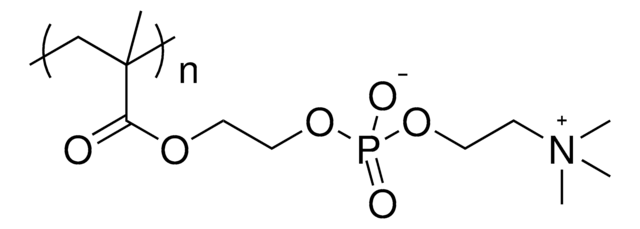925640
Poly (ethylene glycol)-block-Poly (sulfobetaine methacrylate)
PEG average Mn 5000, PSBMA Mn 13,000
Sinónimos:
PEG-PDMAPS, PEG-PSBMA, PSBMA, Poly (sulfobetaine methacrylate)
Iniciar sesiónpara Ver la Fijación de precios por contrato y de la organización
About This Item
Fórmula lineal:
CH3(C2H4O)nC6H7O2N(C11H21O5NS)mOH
UNSPSC Code:
12352112
NACRES:
NA.23
Productos recomendados
mol wt
PEG average Mn 5000
PSBMA Mn 13,000
Quality Level
Categorías relacionadas
Application
Biocompatible, non-fouling block copolymer composed of a neutral PEG block and a zwitterionic poly(sulfobetaine methacrylate) (PSBMA) block.
Poly(sulfobetaine methacrylate) (PSBMA) is a well-known zwitterionic polymer, it is non-toxic and biocompatible. On each of its repeating unit, it carries both a positive charge and a negative charge, leading to its strong hydration capacity.
Surfaces coated with PSBMA showed super hydrophilic property and strong resistance to protein adsorption/bacterial adhesion, making this polymer a promising material in anti-fouling applications.
Poly(sulfobetaine methacrylate) (PSBMA) is a well-known zwitterionic polymer, it is non-toxic and biocompatible. On each of its repeating unit, it carries both a positive charge and a negative charge, leading to its strong hydration capacity.
Surfaces coated with PSBMA showed super hydrophilic property and strong resistance to protein adsorption/bacterial adhesion, making this polymer a promising material in anti-fouling applications.
Storage Class
11 - Combustible Solids
wgk_germany
WGK 3
flash_point_f
Not applicable
flash_point_c
Not applicable
Elija entre una de las versiones más recientes:
Certificados de análisis (COA)
Lot/Batch Number
Lo sentimos, en este momento no disponemos de COAs para este producto en línea.
Si necesita más asistencia, póngase en contacto con Atención al cliente
¿Ya tiene este producto?
Encuentre la documentación para los productos que ha comprado recientemente en la Biblioteca de documentos.
Jiang Wu et al.
Acta biomaterialia, 40, 172-181 (2016-05-05)
Nonfouling materials such as neutral poly(ethylene glycol) (PEG) and zwitterionic poly(sulfobetaine methacrylate) (pSBMA) are ideal biocompatible materials for drug, especially protein drug delivery. The interaction behavior of protein between the nonfouling materials could cause great impact on their future applications
Se Yeong Lee et al.
Biomaterials research, 22, 3-3 (2018-02-17)
Zwitterionic molecules have been widely studied as coating materials for preparing anti-fouling surfaces because they possess strong hydration properties that can resist non-specific protein adsorption. Numerous studies on surface modification using zwitterionic molecules have been investigated, such as electrochemically mediated
Nuestro equipo de científicos tiene experiencia en todas las áreas de investigación: Ciencias de la vida, Ciencia de los materiales, Síntesis química, Cromatografía, Analítica y muchas otras.
Póngase en contacto con el Servicio técnico![[2-(Methacryloyloxy)ethyl]dimethyl-(3-sulfopropyl)ammonium hydroxide 95%](/deepweb/assets/sigmaaldrich/product/structures/217/219/73c91e1c-0ee4-4b3d-bead-a6dc3d09d1da/640/73c91e1c-0ee4-4b3d-bead-a6dc3d09d1da.png)







![[3-(2-Aminoethylamino)propyl]trimethoxysilane technical grade, ≥80%](/deepweb/assets/sigmaaldrich/product/structures/149/508/f87a9a89-f138-4c5e-9fe0-6561914241c3/640/f87a9a89-f138-4c5e-9fe0-6561914241c3.png)